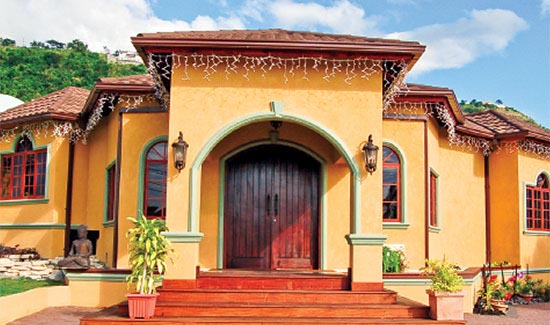The sixties were Jamaica’s glory days… a time when Jamaica was known as the jewel of the Caribbean. Life was much simpler and uncomplicated. After all, we simply copied or absorbed what was passed on to us. Under the British influence, houses were made with wooden jalousies, wide porches, patterned railings and fretwork.
This dominated architecture in the colonial period, reflecting an outdoor lifestyle. Typically homes were built with stone and wood, with stone or cement as the foundation. The kitchen, washroom, and “servant” quarters were located separately or at the back of the main building. The traditional peasant dwelling was a two-room rectangular structure with a pitched thatched roof and walls of braided twigs covered with whitewashed mud or crude wooden planks. (Wattle and Daub) They were quaint and charming and reminded us of our Colonial past. These homes were replaced by cinderblock walls and corrugated roofs. Furnishings in these homes were also of the British Colonial Era mixed with a Spanish influence
The seventies promised so much but delivered so little. The economy took a battering and Housing Schemes became the order of the day in urban Jamaica. Furniture purchases were considered a lifetime investment and a new status symbol. This investment gave birth to the protective practice of putting plastic slipcovers on living room suites and crocheted doilies on hard furnishings. It was understood that things had to last. Living rooms were considered untouchable and were only used a few times a year, specifically a visit from the Pastor or important visitors from the community or abroad. – Children were always banned.
The eighties brought about construction of townhouses in the city and mega mansions in the suburbs and rural communities, dominated by returning residents. Nationalism which was aggressively highlighted began to reflect pride in Jamaican culture. Decorating in this era had taken a turn with wall hangings moving from ‘still life’ to the display of brash Jamaican images.
Local artists were no longer starving or given recognition posthumously. Simultaneously, the American influence which all but dominated all external cultures began to make its mark. From subtle colours and sharp lines, we began the process of including what was then called the American style of bright colours, carved woodwork and a kind of “in your face” statement. When coupled with the arrival of barrels and containers, filled with furnishings and appliances, the steadfast hold of British Colonial style of decorating had been broken. Terrazzo floor tiles and gypsum ceiling tiles of the sixties and seventies were quickly becoming a passing memory. Hurricanes aside, roofing materials like slab, concrete and zinc were now competing with attractive clay and concrete tiles. The sixties children had now grown up and were out on their own. With a desire to express their own individuality, they opted for a more modern relaxed approach to decorating which leaned toward the American influence.
The issue of security became a major consideration for most Jamaicans and urban dwellers who tended to set the trends in lifestyle living, demanded and were presented with the “Gated Community”. These communities are now the accepted and expected standard whether in an urban or rural setting. The modern Townhouse or Gated community has become the status symbol of the day. From the days of colonialism, putting your house on the top of a hill reflected power; a subtle suggestion of superiority. Today the Hills continue to thrive with the consistent ascension of the middle class through diligence and determination for betterment.
The new millennium brought about more technology, energy efficiency and green globe awareness. Newly built homes have all the modern conveniences found in North America. The issue of not being able to find fixtures, fittings and furnishings in Jamaica are now a thing of the past. The family structure is also radically different from 50 years ago, so the home functions differently. Space is also now an issue and the new developments being constructed are very economical with space calling for lifestyle changes which include a more Spartan approach to furnishing, but with a greater emphasis on comfort and convenience. The lifestyle calls for low maintenance of furnishings, an uncluttered environment with clean uncomplicated lines catering to a people on the rise.

